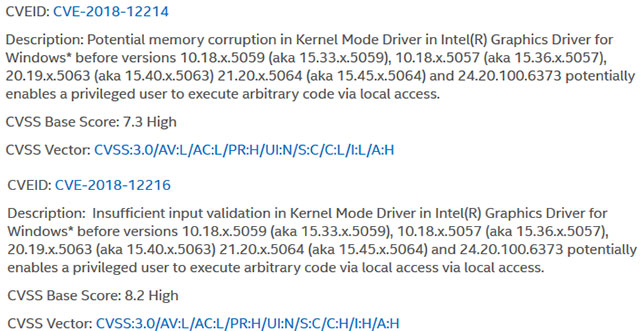Intel has overcome serious vulnerabilities in graphics drivers for Windows
Intel recently announced that it has successfully overcome 20 security vulnerabilities in Intel Graphics Driver for Windows, resulting in escalation of system privileges, denial of service or Disclosure of information if exploited by an attacker with access to the targeted system.
According to QSR security recommendations released two days ago, Intel has released several updates for Windows graphics drivers, designed to minimize the many vulnerabilities found by security researchers from Genuine and worldwide.

- Intel CVAT, a handy open source data annotation toolkit
Of the 20 vulnerabilities found on Intel Graphics Driver for Windows, two were rated to contain extremely high levels of risk with CVSS Base Scores of 7.3 and 8.2, allowing attackers to execute local code. optionally after escalating possession of privileges on the victim's system.
An attacker requires local access to exploit the Intel Graphics Driver vulnerability
To be more precise, security issues, even if strictly monitored, such as CVE-2018-12214 and CVE-2018-12216, can still lead to local user privileges after a set error. Remember the potential as well as the lack of input authentication of the Kernel Mode (Kernel Mode Drive) driver.
The remaining 18 vulnerabilities are all considered low and medium security risks, and have been patched by Intel. More specifically, all of these vulnerabilities can be exploited through local attack vectors with complexity in the way deployments are not so significant, and also without the need for human interaction. use. Of course, among them, there are still some flaws that need user interaction: CVE-2018- 18090 and CVE-2018-18091, they need this factor to activate the DoS status.

- Intel and Qualcomm show off the hardware prototype that allows the integration of 5G into computers
As detailed in the security recommendation, "Intel recommends Intel Graphics Driver for Windows users to update to version 10.18.x.5059 (also called 15.33.x.5059), 10.18.x. 5057 (also called 15.36.x.5057), 20.19.x.5063 (also called 15.40.x.5063) 21.20.x.5064 (also called 15.45.x.5064) and 24.20.100.6373 or more ".
The product is affected
Versions affected by vulnerabilities include Intel Graphics Driver for Windows before versions 10.18.x.5059 (also called 15.33.x.5059), 10.18.x.5057 (also called 15.36.x.5057). ), 20.19.x.5063 (also called 15.40.x.5063) 21.20. x.5064 (also called 15.45.x.5064) and 24.20.100.6373.
All Intel Graphics Driver for Windows security updates are available for download from the Intel Drivers & Software Download Center page.

- Intel officially introduced the Ice 10nm CPU, promising to be available on PCs shipped later this year
In addition, Intel also said it discovered two high-risk vulnerabilities (CVE-2019-0135 and CVE-2019-0121) on the Intel Matrix Storage Manager and the management. Intel Accelerated Storage Manager (Intel Accelerated Storage Manager) in RSTe software can allow escalation to possess system privileges.
In addition, two other medium severity software bugs (CVE-2019-0122 and CVE-2019-0129) were also found, affecting Intel software protection extension tool (Intel Software Guard Extensions - SGX) SDK and Intel USB 3.0 Creator Utility, which can in turn lead to denial of service, theft of information and system privileges.
You should read it
- Intel rolls out Intel Graphics Driver update to support Windows 11
- Intel updates its graphics, WiFi and Bluetooth drivers for Windows 10
- Microsoft confirms Intel SST audio driver causes blue screen errors for Windows 11 computers
- Intel HD 4000 Graphics chip increases 10% performance
- Intel releases a new driver update package to improve the connection between phone and PC
- What is Intel HD Graphics Control Panel? Steps to install and fix Intel HD Graphics Control Panel error
 Counter-Strike 1.6 features new Zero-Day, allowing malicious servers to hack gamers' computers
Counter-Strike 1.6 features new Zero-Day, allowing malicious servers to hack gamers' computers Detects code execution vulnerabilities in WinRAR, noting more than 100 infringement cases
Detects code execution vulnerabilities in WinRAR, noting more than 100 infringement cases If using an Android phone, be careful: You may be being tracked without knowing
If using an Android phone, be careful: You may be being tracked without knowing Ransomware LockerGoga is making a big corporation miserable
Ransomware LockerGoga is making a big corporation miserable The 13-year-old 'Hacker' enters the school's computer system to create a 'list of the most hated kids'
The 13-year-old 'Hacker' enters the school's computer system to create a 'list of the most hated kids' Netflix test mobile movie package only 3 USD / month
Netflix test mobile movie package only 3 USD / month